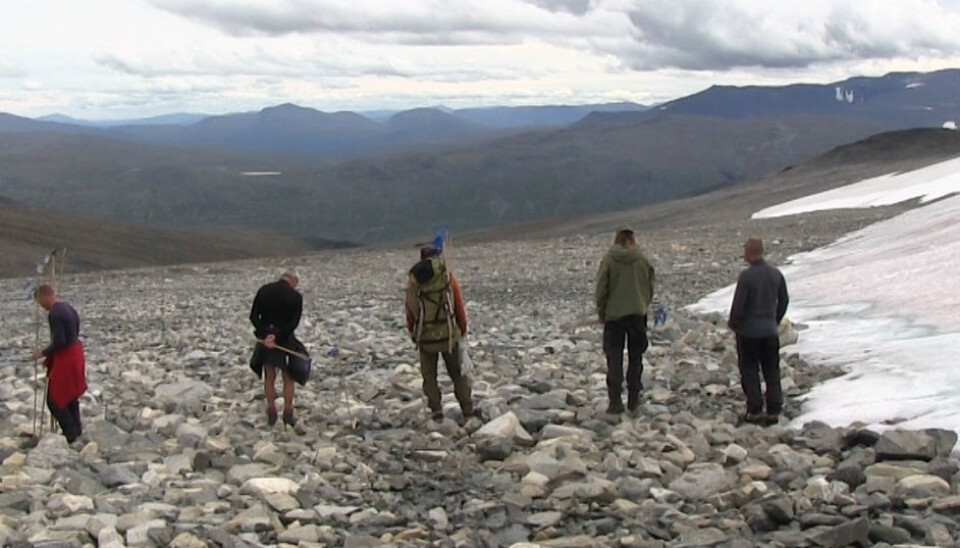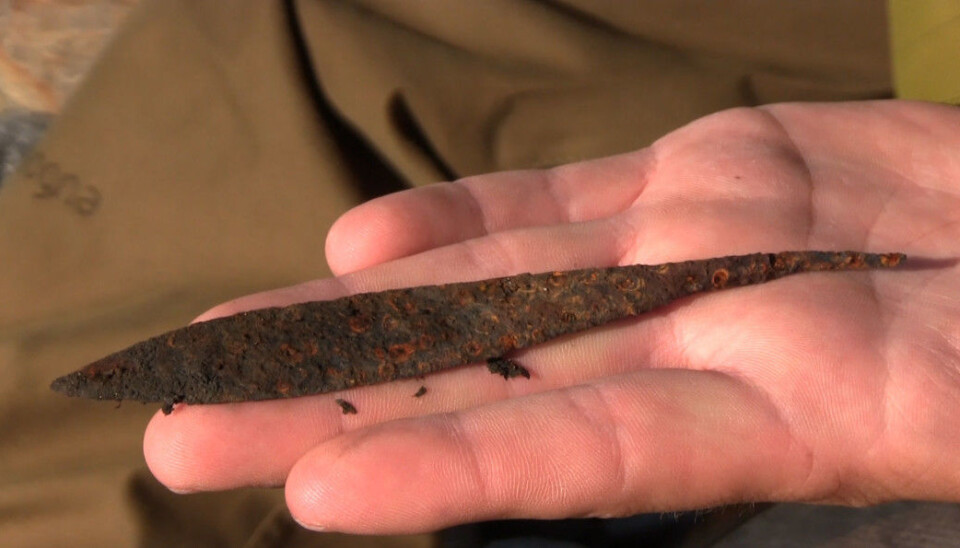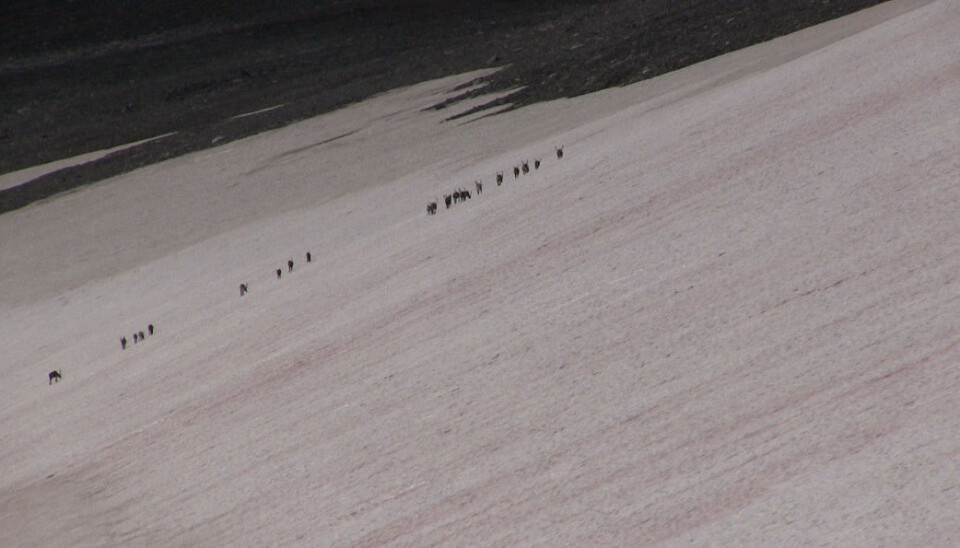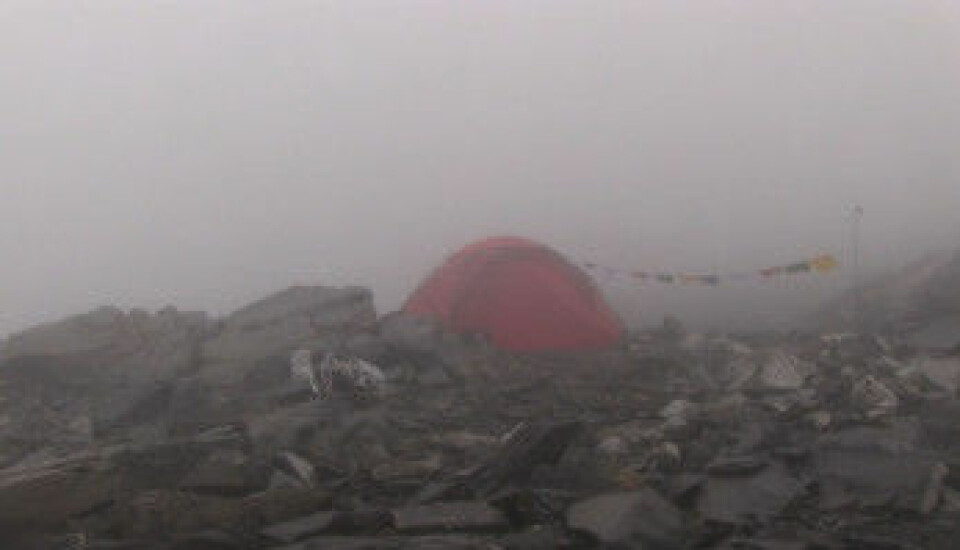
Viking arrowheads emerge from melting Norwegian glaciers
High up in the mountains, archaeologists are now discovering human traces dating as far back as the Stone age.
Julian Martinsen bends down and places a tape measure next to a small treasure located between two large rocks. He is the curator and archaeologist in Oppland County and has been tasked with picking up and packing the artefacts that the team of archaeologists find.
“This is a rare specimen, a bird point,” says Martinsen, as he picks a mysterious arrowhead up off the ground. The arrow has a very special appearance. The point is split in half, like two knife blades facing each other.
According to Martinsen, it stems from the Viking Age, between 900 and 1050 CE. The dating is based on what kinds of arrows and building techniques people used in different time periods.
This is one of the arrows that have melted out of an old glacier on the mountain Kvitingskjølen in southern Norway’s Jotunheimen range. The archaeologists are looking for objects that —until now — have been buried under the ice pack. Some may be thousands of years old.
Across the spine
Espen Finstad and Lars Pilø are archaeologists in Oppland County and co-direct the glacier work. Finstad has tested different found arrowheads, shooting them at an already-dead reindeer.
According to Finstad, the bird arrow was very effective. “The hunters stood at fairly close range and shot the arrows from different positions on the glacier,” he said.
“We stood maybe ten meters away when we tested them out. Several of our shots severed the backbone, so it had would have killed the animal instantly,” he adds.
Watch as an ancient arrow head is picked up for the first time in 1000 years. English subtitles available. (Video by Lasse Biørnstad):
Reindeer hunting
“Look, there come the reindeer,” says archaeologist Elling Wammer as he stands looking down the snowfield.
Farther down the valley small dark dots are slowly moving onto the white snow.
The sun has begun to take hold and the reindeer are moving to higher elevations to flee the terrible plague of parasitic warble flies (Hypoderma tarandi). These are fairly large, bumblebee-like insects that lay their eggs in reindeer fur. The larvae grow under the skin and create ugly sores on the reindeer when they emerge in early summer.
In the snowy heights where the air is too cold for the flies, reindeer can find a reprieve from them.
Hunters have known for thousands of years that the reindeer move up onto the glacier. Earlier the reindeer were wild, but now domesticated reindeer live down in the valley. This is one of the reasons why the archaeologists are here today.
“The oldest finds here are around 6000 years old,” says Finstad, “which means that there’s been hunting here for at least that long.”
He says that over 500 trapping pits have been recorded in Sjødalen in Jotunheimen. The pits are holes in the ground that have been covered with twigs and moss. When animals fall into them, the hunters can kill them.
The archa3eologists are also familiar with numerous spots on the glacier where hunters could hide behind stone walls as they waited for the reindeer to come closer.
Misses become finds
Through the centuries, hunters on the glacier missed some of their targets and lost or discarded arrows in the snow, along with shoes and many other items. The snow covered them and they disappeared into the ice pack.
But since several glaciers and ice patches in Norway have been receding, it also means that the arrows are once again seeing the light of day. All the archaeologists have to do when they find them is gently pick them up from the ground.
Archaeologists in Oppland have made many spectacular discoveries, including an ancient ski with an intact binding. You can see more of these findings on their Facebook page.

The trick is to be able to pick out the objects in the crevices from the millions of broken rocks before it's too late. Weather and wind can damage the artefacts if they become exposed to the elements for too long, since the ice no longer encases and protects them.
Some parts of the glaciers are several thousand years old. (Video by Lasse Biørnstad):
Black ice
The ice patch on Kvitingskjølen is old. New snow has fallen and old snow has melted, but snow and ice have been here for several thousand years.
“This is called black ice,” says Pilø, standing at its edge.
The black, dirty ice is clearly visible. The ice may have formed as far back as the Stone Age, emerging now because the newer ice on top is melting. Dirt and debris from the newer layers accumulate on top of the old.
The black ice is divulging new discoveries. The artefacts are amazingly well preserved, since the ice has encased them since they were lost centuries ago.
Previously, the archaeologists found arrows more than a thousand years old that are practically intact, with lashing around the arrowhead and almost complete fletching.
The arrows further from the edge of the ice are more susceptible to the weather, and they have alternated between being encased in ice and lying out in the open. Although the ice patches are shrinking over time, the ice mass varies greatly from year to year.
Pilø confirms that overall, the glacier has shrunk dramatically in the last 10-15 years.
Ice protects metal arrow tips like the bird point — as well as fragile wood and clothing — from the degrading effects of air and salt.
“This slows down the corrosion process by thousands of years,” says Martinsen. He is examining another arrowhead that was found in the scree slope, perhaps from an earlier Viking era.
The retreating ice exposes these ancient objects to the elements. Archaeologists know they need to hurry to find the artefacts before they disintegrate or disappear into the rocky slope.
Grid search
The archaeologists employ a time-consuming grid system for their excavating work.
The team has just moved down into the small valley alongside the glacier. As the ice melts, the water flows down the valley, and the melt water can carry wood and other objects downstream.
Elling Wammer has been doing glacial excavation for years and heads up this group.

“We move slowly at two meter intervals and comb the area,” says Wammer.
But with thousands of rocks and crevices, it’s impossible to know whether the archaeologists have found everything.
The search area is huge, and they approach the task systematically. As they walk, they erect bamboo sticks, moving back and forth until they have covered every square meter of the grid site.
When the archaeologists find something, they flag it. Afterwards, Martinsen comes through to pick up the artefacts, measure them and plot their GPS coordinates.
They sometimes do this for hours, looking for any possible signs of human activity. Any wooden objects were almost certainly brought there by people at one time or another, since the area is far above the tree line.
On this day the archaeologists seemed a little impatient. They had gone several hours without finding anything.
Wammer says that for their understanding of the area it’s still important to look, to know where artefacts are more and less abundant.
During recent years, archaeologists have found more than 2000 objects in different snowdrift glaciers in central Norway.
This is how archaeologists search for objects along the edge of the ice patch. (Video by Lasse Biørnstad):
“Scare sticks”
The day before the team had found several arrows, but on this day historical relics are long in coming.
But then things shift in a quite unexpected way. The exploration team comes across a discovery marked by a stick with a small blue flag, but it isn’t one they put there this time.

“It's actually something we forgot last year,” chuckles Wammer.
The archaeologists were here last year, but this find was overlooked. The blue flag marks a broken “scare stick”. This is among the most common finds archaeologists make on the glacier.
Scare sticks were used as a kind of fence to direct reindeer where hunters wanted them to go. They were stuck in the snow every few meters and would have a small string or piece of birch bark tied on at the top. When it fluttered in the wind, the motion frightened the animals and they would stay within the bounds of the poles.
“They were pretty meticulous with this one,” says Martinsen as he picks up the stick from the rocks. Like many other wooden objects on the glacier, it’s broken into several pieces, but the top is intact.
One can see quite clearly that someone has taken the trouble to whittle a notch for attaching a string or small piece of wood.
“We know that [scare sticks] were used around 300-500 CE, and they were also used in the Viking Age,” says Martinsen when asked if it’s possible to estimate its age.
One more discovery is made right at the end of the day — a lucky find. Archaeology student Andreas Ropeid Saebø happened to move some rocks, and up popped a small leather strap.
“It looks like a strap made of rawhide that belonged to a leather shoe,” says Martinsen upon inspection. “We’ve found this kind of shoe on lots of different glaciers in Norway,” he adds.
The strap might have served as lacing on one of those shoes, “but there’s no telling how old it is”, he says.
“We want the ice to melt so that we can make these great discoveries, but of course we want there to be ice in Norwegian nature. It's a mixed blessing,” Pilø says.
———































